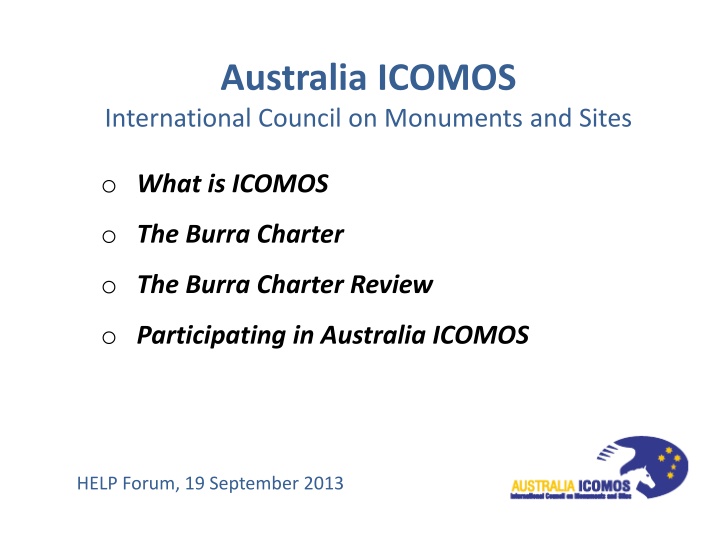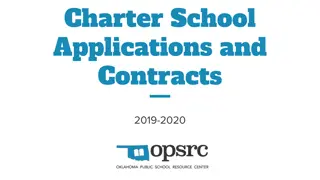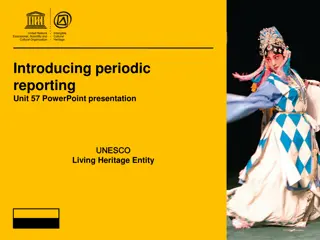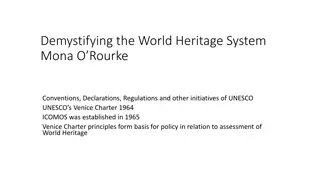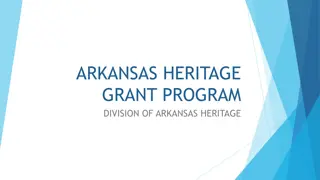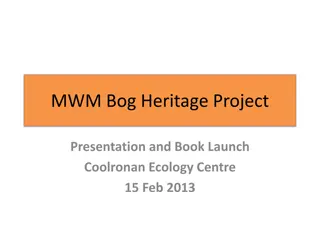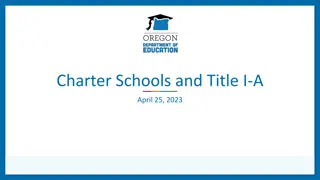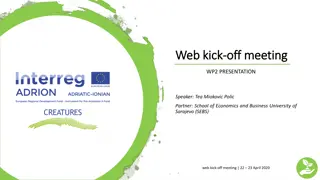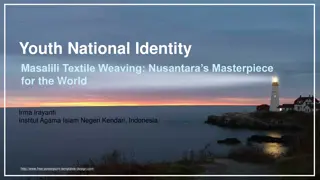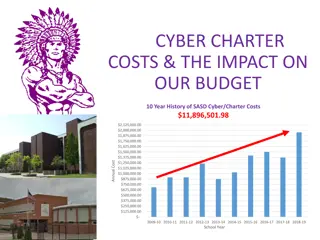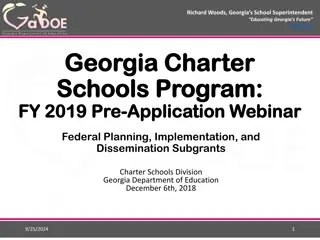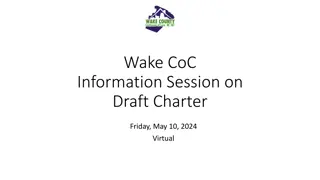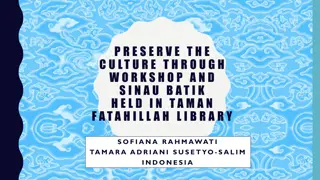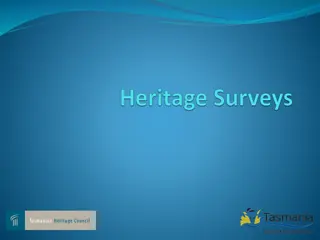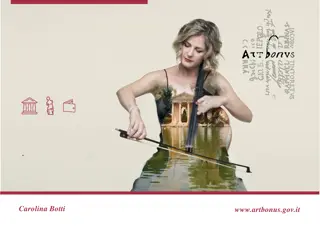Australia ICOMOS and The Burra Charter: Preserving Cultural Heritage
Australia ICOMOS, established in 1976, plays a vital role in promoting the conservation of cultural heritage places. With over 600 members, it focuses on key strategic directions like conservation philosophy, education, advocacy, and membership development. The Burra Charter, endorsed in 1979 and updated in 1981 and 1988, serves as a best practice standard for heritage management in Australia, advocating a cautious approach to preserving cultural significance while allowing necessary care and utility.
Download Presentation

Please find below an Image/Link to download the presentation.
The content on the website is provided AS IS for your information and personal use only. It may not be sold, licensed, or shared on other websites without obtaining consent from the author.If you encounter any issues during the download, it is possible that the publisher has removed the file from their server.
You are allowed to download the files provided on this website for personal or commercial use, subject to the condition that they are used lawfully. All files are the property of their respective owners.
The content on the website is provided AS IS for your information and personal use only. It may not be sold, licensed, or shared on other websites without obtaining consent from the author.
E N D
Presentation Transcript
Australia ICOMOS International Council on Monuments and Sites o What is ICOMOS o The Burra Charter o The Burra Charter Review o Participating in Australia ICOMOS HELP Forum, 19 September 2013
What is ICOMOS? The International Council on Monuments and Sites (ICOMOS) is an association of 9,500 members in 110 national committees throughout the world. It was established in 1964 by a resolution of UNESCO. It is the only global non-government organisation, dedicated to promoting the application of theory, methodology and scientific techniques to the conservation of cultural heritage places. Many ICOMOS members participate in the organisation s 27 International Scientific Committees. ICOMOS also has the responsibility of advising UNESCO on World Heritage listed properties and their conservation.
Australia ICOMOS Australia formed a national chapter of ICOMOS in 1976. Australia ICOMOS is a non-government organisation. The Executive Committee co-ordinates a range of national/ state activities and contributes to ICOMOS internationally. Our mission - to lead cultural heritage conservation in Australia by raising and maintaining standards, encouraging debate and generating innovative ideas. Australia ICOMOS has over 600 members, including heritage practitioners, planners, historians, educators, curators, archaeologists, architects, interpretation specialists, conservators, engineers, site managers and qualified tradespeople. Tasmania currently has 24 members, but we know there are more out there!
Australia ICOMOS KEY STRATEGIC DIRECTIONS 1. Conservation Philosophy, Policy and Practice Ensure that Australia ICOMOS takes a leadership role in conservation philosophy and practice for culturally significant places. 2. International Partnerships Participate in the international arena, both within and beyond the ICOMOS International family. 3. Education and Communication Promote an understanding of the cultural significance of places and raise conservation standards through education and communication programs. 4. Advocacy Inform and influence key decision-makers through the communication of Australia ICOMOS aims and approaches to conservation philosophy and practice. 5. Membership Develop, maintain and support a broad-based membership through effective administration.
The Burra Charter The Australia ICOMOS Charter for the Conservation of Places of Cultural Significance 1999 First endorsed in 1979, with updates in 1981 and 1988. This document guides the conservation of cultural heritage places in Australia. The Burra Charter and its accompanying guidelines and practice notes are considered best practice standard for cultural heritage management in Australia. Formally endorsed by the Australian Heritage Council and a number of states (NSW, Qld, Vic, and Tas). Fundamentally, the Charter advocates a cautious approach to changing heritage places: do as much as necessary to care for the place and to make it useable, but change it as little as possible so that its cultural significance is retained.
The Burra Charter Process Investigate the place and its history. Assess and understand significance. Identify all the issues, constraints and opportunities . Develop conservation policies. Prepare a management plan, define priorities and actions. Manage the place and its values. Monitor and review.
Burra Charter Guidelines Review Review undertaken by Andrew Sneddon, Anthony Coupe, David Young, Duncan Marshall, Sandy Blair, Chris Johnston, Rachel Jackson and Alan Croker. Consultation undertaken earlier this year with ICOMOS membership, heritage agencies and NGOs. Documents reviewed and revised: o Burra Charter (Draft 2013) o Practice Note Understanding and assessing cultural significance o Practice Note Developing policy o Practice Note Undertaking studies and reports o Practice Note The Burra Charter and archaeological practice o Practice Note The Burra Charter and Indigenous cultural heritage management o Practice Note Article 22: New work o Practice Note Interpretation The new Burra Charter and Practice Notes to be endorsed at the AGM on 31st October 2013 Suite of new Practice Notes to be developed in 2014
Participating in Australia ICOMOS Range of membership types: o Full International Member o Full International Member (Young Professional) o Associate Member o Associate Member Retired/unwaged or Student o Student Member o Institutional Member Benefits o Weekly email news bulletin o Subscription to the Australia ICOMOS refereed journal Historic Environment o Regular newsletters from ICOMOS headquarters in Paris o International ICOMOS membership card (FIM) o Opportunities to participate in national and international ICOMOS activities including International Scientific Committees and advisory committees o Professional networking opportunities o Discounts on ICOMOS publications, functions and conferences o Access to professional information through the members only section of the website
Australia ICOMOS 2013 National Conference, Canberra 31 October 3 November 2013 Conference Website: http://www.aicomos.com/2013-canberra-centenary/ HELP Forum, 19 September 2013
